
The economy of American Samoa is a traditional Polynesian economy in which more than 90% of the land is communally owned. Economic activity is strongly linked to the United States, with which American Samoa conducts the great bulk of its foreign trade. Tuna fishing and processing plants are the backbone of the private sector, with canned tuna being the primary export. Transfers from the U.S. federal government add substantially to American Samoa's economic well-being. Attempts by the government to develop a larger and broader economy are restrained by Samoa's remote location, its limited transportation, and its devastating hurricanes.

The economy of Gabon is characterized by strong links with France, large foreign investments, dependence on skilled foreign labor, and decline of agriculture. Gabon on paper enjoys a per capita income four times that of most nations of Africa, but its reliance on resource extraction industry fail to release much of the population from extreme poverty, as much of 30% of the population lives under the poverty threshold.

The economy of Kyrgyzstan is heavily dependent on the agricultural sector. Cotton, tobacco, wool, and meat are the main agricultural products, although only tobacco and cotton are exported in any quantity. According to Healy Consultants, Kyrgyzstan's economy relies heavily on the strength of industrial exports, with plentiful reserves of gold, mercury and uranium. The economy also relies heavily on remittances from foreign workers. Following independence, Kyrgyzstan was progressive in carrying out market reforms, such as an improved regulatory system and land reform. In 1998, Kyrgyzstan was the first Commonwealth of Independent States (CIS) country to be accepted into the World Trade Organization. Much of the government's stock in enterprises has been sold. Kyrgyzstan's economic performance has been hindered by widespread corruption, low foreign investment and general regional instability. Despite those issues, Kyrgyzstan is ranked 70th on the ease of doing business index.

The economy of North Macedonia has become more liberalized, with an improved business environment, since its independence from Yugoslavia in 1991, which deprived the country of its key protected markets and the large transfer payments from Belgrade. Prior to independence, North Macedonia was Yugoslavia's poorest republic. An absence of infrastructure, United Nations sanctions on its largest market, and a Greek economic embargo hindered economic growth until 1996.
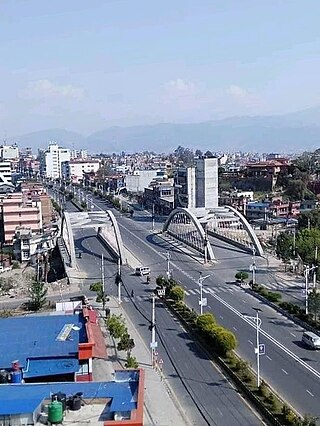
The economy of Nepal is developing category and largely dependent on agriculture and remittances. Until the mid-20th century Nepal was an isolated pre-industrial society, which entered the modern era in 1951 without schools, hospitals, roads, telecommunications, electric power, industry, or civil service. The country has, however, made progress toward sustainable economic growth since the 1950s. The country was opened to economic liberalization, leading to economic growth and improvement in living standards when compared to the past. The biggest challenges faced by the country in achieving higher economic development are the frequent changes in political leadership, as well as corruption.
The Netherlands Antilles was an autonomous Caribbean country within the Kingdom of the Netherlands, which was formally dissolved in 2010.

The economy of Senegal is driven by mining, construction, tourism, fishing and agriculture, which are the main sources of employment in rural areas, despite abundant natural resources in iron, zircon, gas, gold, phosphates, and numerous oil discoveries recently. Senegal's economy gains most of its foreign exchange from fish, phosphates, groundnuts, tourism, and services. As one of the dominant parts of the economy, the agricultural sector of Senegal is highly vulnerable to environmental conditions, such as variations in rainfall and climate change, and changes in world commodity prices.
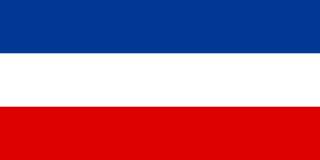
Serbia and Montenegro, known until 2003 as the Federal Republic of Yugoslavia, FR Yugoslavia (FRY) or simply Yugoslavia, was a country in Southeast Europe located in the Balkans that existed from 1992 to 2006, following the breakup of the Socialist Federal Republic of Yugoslavia. The country bordered Hungary to the north, Romania to the northeast, Bulgaria to the southeast, North Macedonia to the south, Croatia and Bosnia and Herzegovina to the west, and Albania to the southwest. The state was founded on 27 April 1992 as a federation comprising the Republic of Serbia and the Republic of Montenegro. In February 2003, it was transformed from a federal republic to a political union until Montenegro seceded from the union in June 2006, leading to the full independence of both Serbia and Montenegro.

The world economy or global economy is the economy of all humans in the world, referring to the global economic system, which includes all economic activities conducted both within and between nations, including production, consumption, economic management, work in general, financial transactions and trade of goods and services. In some contexts, the two terms are distinct: the "international" or "global economy" is measured separately and distinguished from national economies, while the "world economy" is simply an aggregate of the separate countries' measurements. Beyond the minimum standard concerning value in production, use and exchange, the definitions, representations, models and valuations of the world economy vary widely. It is inseparable from the geography and ecology of planet Earth.
The economy of the Socialist Federal Republic of Yugoslavia (SFRY) was a unique system of socialist self-management that operated from the end of World War II until the country's dissolution in the 1990s. The Yugoslav economy was characterized by a combination of market mechanisms and state planning, with a focus on worker self-management and a decentralized approach to decision-making. Despite facing numerous challenges, including political instability and external pressures, the Yugoslav economy achieved significant growth and modernization during its existence, with a particularly strong emphasis on education, health care, and social welfare. However, the system ultimately proved unsustainable in the face of the global economic changes of the 1980s and the political tensions that led to the breakup of Yugoslavia in the 1990s. Despite common origins, the Yugoslav economy was significantly different from the economies of the Soviet Union and other Eastern European socialist states, especially after the Yugoslav-Soviet break-up in 1948.

The economy of Serbia is a service-based upper-middle income economy in the Central Europe, with the tertiary sector accounting for two-thirds of total gross domestic product (GDP). The economy functions on the principles of the free market. Nominal GDP in 2024 is projected to reach $81.873 billion, which is $12,385 per capita, while GDP based on purchasing power parity (PPP) stood at $185.014 billion, which is $27,985 per capita. The strongest sectors of Serbia's economy are energy, the automotive industry, machinery, mining, and agriculture. The country's primary industrial exports are automobiles, base metals, furniture, food processing, machinery, chemicals, sugar, tires, clothes, and pharmaceuticals. Trade plays a major role in Serbian economic output. The main trading partners are Germany, Italy, Russia, China, and neighbouring Balkan countries.
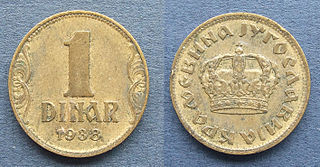
The dinar was the currency of Yugoslavia. It was introduced in 1920 in the Kingdom of Serbs, Croats and Slovenes, which was replaced by the Kingdom of Yugoslavia, and then the Socialist Federal Republic of Yugoslavia. The dinar was subdivided into 100 para.
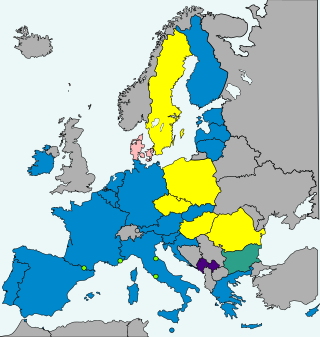
Montenegro is a country in South-Eastern Europe, which is neither a member of the European Union (EU) nor the Eurozone; it does not have a formal monetary agreement with the EU either. However, it is one of the two territories that has unilaterally adopted the euro in 2002 as its de facto domestic currency. This means that even though the euro is not a legal tender there, it is treated as such by the government and the population.

Kosovo adopted the euro as its de facto legal tender in 2002 despite the territory not being a member of the Eurozone or the European Union. This succeeded its use of German marks from 1999.

The Republic of Serbia was a constituent state of the Federal Republic of Yugoslavia between 1992 and 2003 and the State Union of Serbia and Montenegro from 2003 to 2006. With Montenegro's secession from the union with Serbia in June 2006, both became sovereign states in their own right for the first time in nearly 88 years.

The Republic of Montenegro was a constituent federated state of the Federal Republic of Yugoslavia and then Serbia and Montenegro between 1992 and 2006. The declaration of independence of Montenegro in 2006 ended the ex-Yugoslav state. After the collapse of the Socialist Federal Republic of Yugoslavia (SFRY), the remaining republics of Montenegro and Serbia agreed to the formation of the Federal Republic of Yugoslavia (FRY) which officially abandoned communism and nominally endorsed democratic institutions. Montenegro was a constituent republic of the FRY and its successor state until June 2006 when Montenegro declared independence from Serbia and Montenegro following the 2006 Montenegrin independence referendum.
The economy of Guam depends mainly on US military spending and on tourist revenue. Over the past 20 years, the tourist industry grew rapidly, creating a construction boom for new hotels, golf courses and other tourist amenities. More than 1.1 million tourists visit Guam each year including about 1,000,000 from Japan and 150,000 from Korea. Setbacks in the 1990s include numerous super-typhoons, a M7.8 earthquake, and a Korean airline crash.
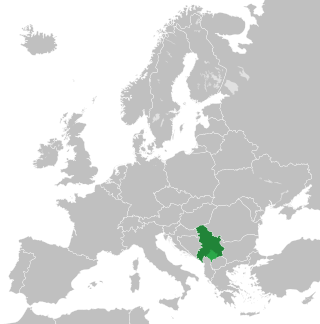
During the Yugoslav Wars of the 1990s and early 2000s, several rounds of international sanctions were imposed against the former Yugoslav republics of Serbia and Montenegro that formed a new country called the Federal Republic of Yugoslavia.

Between 1992 and 1994, the Federal Republic of Yugoslavia (FRY) experienced the second-longest period of hyperinflation in world economic history, caused by an explosive growth in the money supply of the Yugoslav economy during the Yugoslav Wars. This period spanned 22 months, from March 1992 to January 1994. Inflation peaked at a monthly rate of 313 million percent in January 1994. Daily inflation was 62%, with an inflation rate of 2.03% in 1 hour being higher than the annual inflation rate of many developed countries. The inflation rate in January 1994, converted to annual levels, reached 116,545,906,563,330 percent (116.546 trillion percent, or 1.16 × 1014 percent). During this period of hyperinflation in FR Yugoslavia, store prices were stated in conditional units – point, which was equal to the German mark. The conversion was made either in German marks or in dinars at the current "black market" exchange rate that often changed several times per day.
Serbia has been a member of the International Monetary Fund (IMF) since December 14, 2022 with a quota of Special Drawing Rights (SDR) 654.8 million and 8,0007 votes. Serbia is currently represented on the Executive Board by Piotr Trabinski in a constituency with Azerbaijan, Kazakhstan, the Kyrgyz Republic, Poland, Serbia, Switzerland, Tajikistan, Turkmenistan, and Uzbekistan that holds 2.88% of the total vote share.














